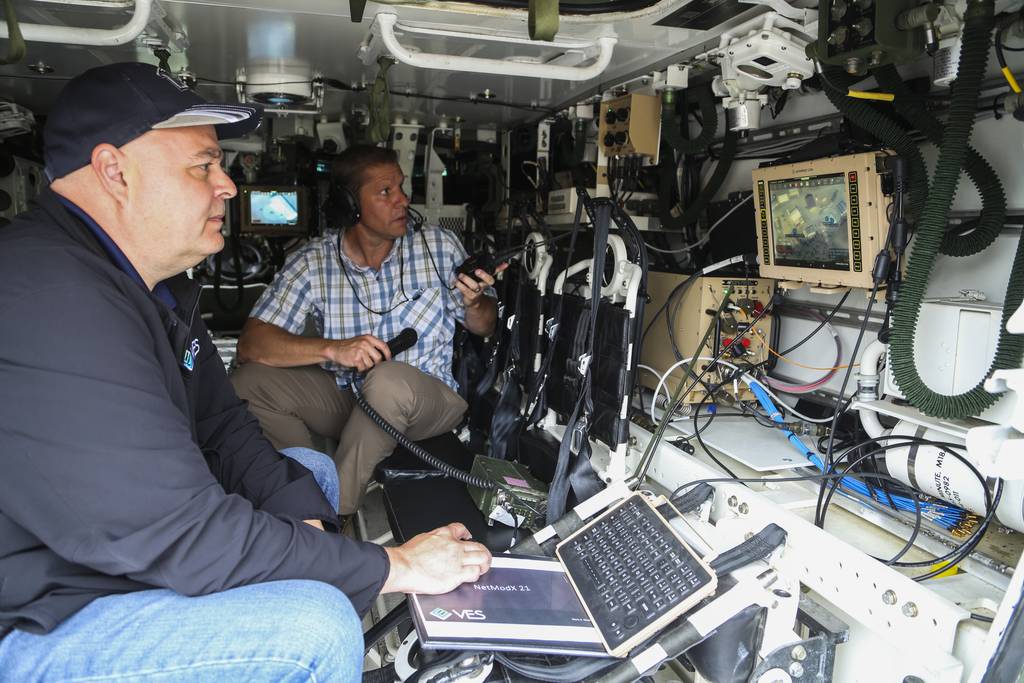WASHINGTON — The U.S. Army network research team reported various advances at its latest annual experiment that could translate to future battlefield capabilities.
The C5ISR Center tested numerous technologies this summer for manned-unmanned teaming and advanced network communications techniques at its Network Modernization Experiment, a field-based event at Joint Base McGuire-Dix-Lakehurst in New Jersey to try tools in an operational environment.
A primary takeaway from the experiment was that a critical open standards project for Army’s future battlefield network works. The C5ISR/EW Modular Open Suite of Standards, or CMOSS, allows soldiers to upgrade capabilities more simply by plugging a rugged standard VPX card into a small box.
The C5ISR Center team responsible for developing CMOSS brought a prototype to NetModX and attempted to integrate a TSM waveform that works with software-defined radios; a position, navigation and timing solution; as well as mounted mission command applications. CMOSS is based on an open standards architecture that increases the interoperability of tools.
“The more important lesson we learned is that the standards work,†Ben Peddicord, the C5ISR Center’s branch chief for intel technology and architecture, said during a July media roundtable.
“So we were able to bring together a number of solutions from a number of vendors, and very quickly and easily — I mean, like, within days — successfully integrate them and help them execute their mission. So I think we learned some specific very narrow technical issues that we need to work on. Nothing significant, but most importantly, I think we really demonstrated the power of the standards.â€
The Army plans to field CMOSS capability on Stryker armored vehicles for Capability Set ‘25, one of the service’s rollouts of new tactical network technologies that happen every two years. The team also demonstrated interoperability with a dismounted soldier’s Nett Warrior situational awareness tool and with a UH-60 Black Hawk, according to an Army news release.
During the first week of NetModX the research team focused on integrating the three solutions into the larger network. In the following two weeks they experimented with more vendors.
“We were able to, in the following two weeks, have vendors come in and very rapidly in the field, drop their solutions in, and everything really, pretty much just worked,†Peddicord said.
The products included emerging waveforms; assured PNT; CMOSS infrastructure prototypes; and capabilities for data encryption, tactical communication and electronic warfare, according to Peddicord.
The CMOSS experiment at NetModX included participation from L3Harris Technologies, General Dynamics Mission Systems, Spectranetix, Trellisware Technologies, SRC Inc., Curtiss-Wright Corp. and Collins Aerospace.
The C5ISR Center also tested a developing network capability for robotic combat vehicles that would give operators an improved understanding of their radio connection to the vehicle. Currently, operators can maneuver the vehicle until their link dies and the robot becomes “orphaned†on the battlefield, said Archie Kujawski, lead of the future radio concepts team.
“We saw a need for the end operators to be able to visualize the battle space for that remote link through the radios and to visualize that as they move across the battle space, and we saw that as a pretty big need in order to enable that link,†Kujawski told reporters in late July.
In response, the C5ISR Center developed a Network Coverage Overlay that allows robot combat vehicle operators to visualize the strength of their connection with the colors green, amber and red, according to Jonathan Lee, lead of the spectrum research and development team. The tool displays a coverage heat map that estimates radio signal strength based on terrain and elevation. The end goal is a capability that will notify users when their connection is degrading.
“One benefit that allows a user to gain knowledge of where they will have real network coverage,†Lee said at the media event. “This allows the radios to be used better, and allows the vehicle operators to make decisions based on radio connectivity along the different routes, and consequently allowing them to see how far they can send the remotely controlled vehicle.â€
The network researchers also tested anti-jam, covert radio waveform capabilities of command post communications as part of a broader effort to reduce the electronic signatures of the service’s command posts. The Army is pushing for mobile, distributed command posts as it prepares for potential future wars against advanced adversaries such as Russia and China.
At NetModX, the C5ISR Center tested new commercial radios on moving vehicles that could in the future be part of the mobile command post effort, known as Command Post Integrated Infrastructure, an effort led by Program Executive Office Command, Control, Communications-Tactical. The researchers tested two commercial radios from undisclosed companies in a “caravanning†activity in which vehicles rolled around a seven-kilometer course with mixed terrain and foliage, RJ Regars, a C5ISR Center systems engineer, said at another media update in August.
One radio performed well, while the other did not, Regars said without getting into specifics. Neither radio performed well in a second test in which the devices passed off responsibility for maintaining the data link, based on their location. Those results “were as we expected†because the commercial radios weren’t built with tactical use in mind.
“There’s value in understanding both what the commercial systems are doing well, and what they’re not doing well because ... our emphasis is to leverage what we can from the commercial world, and not have to redevelop these things,†Regars said.
Andrew Eversden covers all things defense technology for C4ISRNET. He previously reported on federal IT and cybersecurity for Federal Times and Fifth Domain, and worked as a congressional reporting fellow for the Texas Tribune. He was also a Washington intern for the Durango Herald. Andrew is a graduate of American University.








